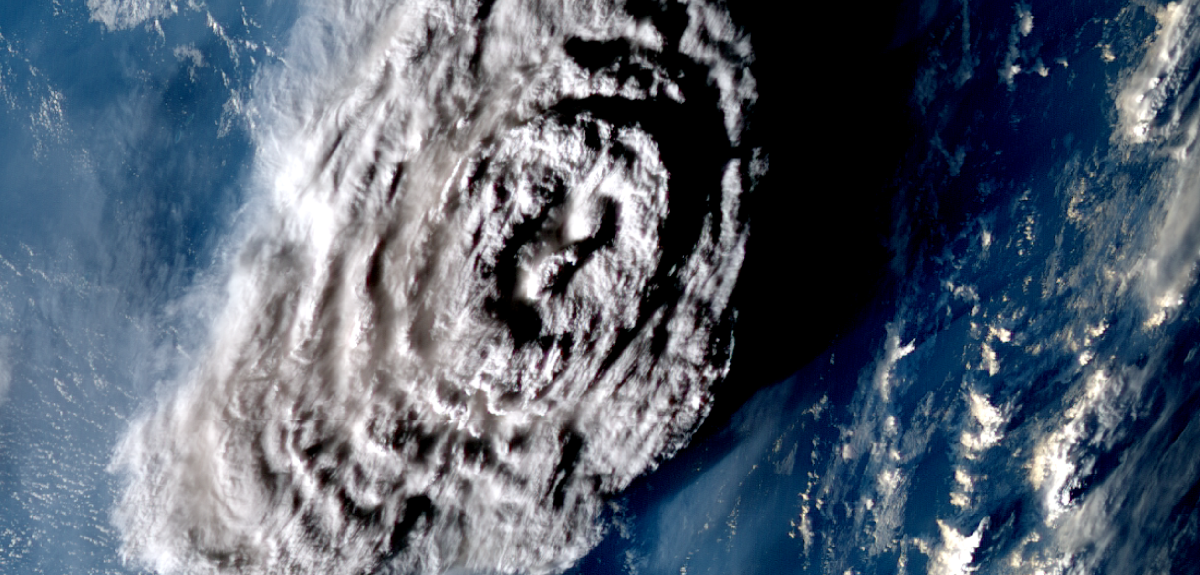
Tonga volcano had highest plume ever recorded, new study confirms
A new analysis led by Oxford University researchers has shown the devastating Hunga Tonga–Hunga Haʻapai eruption in January 2022 created the tallest volcanic plume ever recorded. The research has been published in the journal Science.
At 57km high (35 miles), the ash cloud generated by the eruption is also the first to have been observed in the mesosphere, a layer of the atmosphere more commonly associated with shooting stars. The previous record-holder, the 1991 eruption of Mount Pinatubo in the Philippines, caused a plume was recorded as 40km high, although accurate satellite images, such as those taken over Tonga, were not available at the time.
The Tonga eruption took place under the sea, around 65km from the country’s main island, causing tsunamis felt as far away as Russia, the United States, and Chile. The waves claimed six lives, including two people in Peru, 10,000km away.
 The Hunga Tonga–Hunga Haʻapai eruption as seen by Japan's Himawari-8 satellite on 15 January 2022. Top image: Eruption at 4:20 UTC (about 15 minutes into the eruption); Middle image: Eruption at 4:50 UTC (45 minutes into the eruption); Bottom image: Eruption at 5:40 UTC (1 hour 35 minutes into the eruption). Image credit: Simon Proud / STFC RAL Space / NCEO / JMA.
The Hunga Tonga–Hunga Haʻapai eruption as seen by Japan's Himawari-8 satellite on 15 January 2022. Top image: Eruption at 4:20 UTC (about 15 minutes into the eruption); Middle image: Eruption at 4:50 UTC (45 minutes into the eruption); Bottom image: Eruption at 5:40 UTC (1 hour 35 minutes into the eruption). Image credit: Simon Proud / STFC RAL Space / NCEO / JMA.Normally, the height of a volcanic plume can be estimated by measuring the temperature at its top and comparing it to the standard air temperatures found at various altitudes. This is because, in the troposphere, the lowest layer of the Earth’s atmosphere, temperature decreases with height. But, if the eruption is so large the plume penetrates the higher layers of the atmosphere, this method becomes unreliable, as air temperatures begin to increase again with height.
To overcome this problem, the researchers developed a technique based on a phenomenon called ‘the parallax effect’.
This effect can be seen by closing your right eye, and holding out one hand with the thumb raised upwards. If you switch eyes, so your left is closed and your right is open, the thumb will appear to shift slightly against the background. By measuring this apparent change in position, and combining this with the known distance between your eyes, you can calculate the distance between your eyes and your thumb.
The location of the Tonga volcano is covered by three geostationary weather satellites, 36,000km up in space, so the researchers were able to apply the parallax effect to the aerial images these captured. Crucially, during the eruption itself, the satellites recorded images every 10 minutes, enabling the rapid changes in the plume’s trajectory to be documented.
‘Thirty years ago, when Pinatubo erupted, our satellites were nowhere near as good as they are now. They could only scan the earth every 30 minutes. Or maybe even every hour,’ said Dr Proud.
‘We think for Pinatubo we actually missed the peak of the activity and the points where it went the highest: it fell between two of the satellite images and we missed it. In reality it probably went quite a bit higher than the estimates that we have for its height.’
The mesosphere reaches between approximately 48km and 80km high and is the third layer of the atmosphere, above the troposphere and the stratosphere. Meteors falling to earth often burn up in the mesosphere, causing shooting stars in the night sky. It is the coldest part of Earth’s atmosphere, with temperatures near the top reaching as low as -143°C.
‘The interesting thing is, this eruption put a lot of water into the mesosphere, which is usually a very dry part of the atmosphere,’ said Dr Proud. ‘This makes the eruption a useful test case for how well our climate and weather models can cope with unexpected and extreme conditions.’
The researchers now intend to construct an automated system to compute the heights of volcano plumes using the parallax method. Co-author Dr Andrew Prata from Oxford’s department of Atmospheric, Oceanic & Planetary Physics, said, ‘We’d also like to apply this technique to other eruptions and develop a dataset of plume heights that can be used by volcanologists and atmospheric scientists to model the dispersion of volcanic ash in the atmosphere.’
‘Further science questions that we would like to understand are: Why did the Tonga plume go so high? What will be the climate impact of this eruption? And what exactly was the plume composed of?’
The study, ‘The January 2022 eruption of Hunga Tonga-Hunga Ha’apai volcano reached the mesosphere’ has been published in the journal Science.
The three satellites used to capture and evaluate the eruption were GOES-17 (USA), Himawari-8 (Japan) and GeoKompSat-2A (Korea). The open-access data was processed by the UK’s Jasmin Supercomputer at the Science and Technology Facilities Council’s Rutherford Appleton Lab.
A zoomed-in view of the Hunga Tonga–Hunga Haʻapai eruption on 15 January 2022, recorded by NOAA's GOES-17 weather satellite. Credit: Simon Proud / STFC RAL Space / NCEO / NOAA
 New study estimates NHS England spends 3% of its primary and secondary care budget on the health impacts of temperature
New study estimates NHS England spends 3% of its primary and secondary care budget on the health impacts of temperature
 International collaboration launches largest-ever therapeutics trial for patients hospitalised with dengue
International collaboration launches largest-ever therapeutics trial for patients hospitalised with dengue
 Oxford-built multi-agent assistant for cancer care to be piloted in collaboration with Microsoft
Oxford-built multi-agent assistant for cancer care to be piloted in collaboration with Microsoft
 World's first Phase II Nipah virus vaccine trial launch
World's first Phase II Nipah virus vaccine trial launch